PHCA9505 - Project Piaxtla: Analysis of Participatory Planning
VerifiedAdded on 2023/06/10
|10
|3091
|115
Essay
AI Summary
This essay provides a critical analysis of Project Piaxtla, a rural primary healthcare program in western Mexico, through the lens of participatory planning. It examines the program's evolution from curative care to social action, highlighting its participatory approaches to planning in development and health. The analysis focuses on how needs were assessed and changed over time, who participated in the program, how issues of inequity were addressed, and the extent to which processes and actions aligned with the principles of participatory planning. Key initiatives such as the farmworker-operated maize bank and cooperative fencing program are discussed to illustrate the program's efforts to address the underlying social and economic determinants of health. The essay concludes by evaluating the program's successes and challenges in empowering the community and promoting equitable health outcomes.

Primary Healthcare and its Practice in Developing Countries 1
Primary Healthcare and its Practice in Developing Countries
Student’s Name
Course Code and Name
Instructor’s Name
Institution’s Name
City State
Primary Healthcare and its Practice in Developing Countries
Student’s Name
Course Code and Name
Instructor’s Name
Institution’s Name
City State
Paraphrase This Document
Need a fresh take? Get an instant paraphrase of this document with our AI Paraphraser
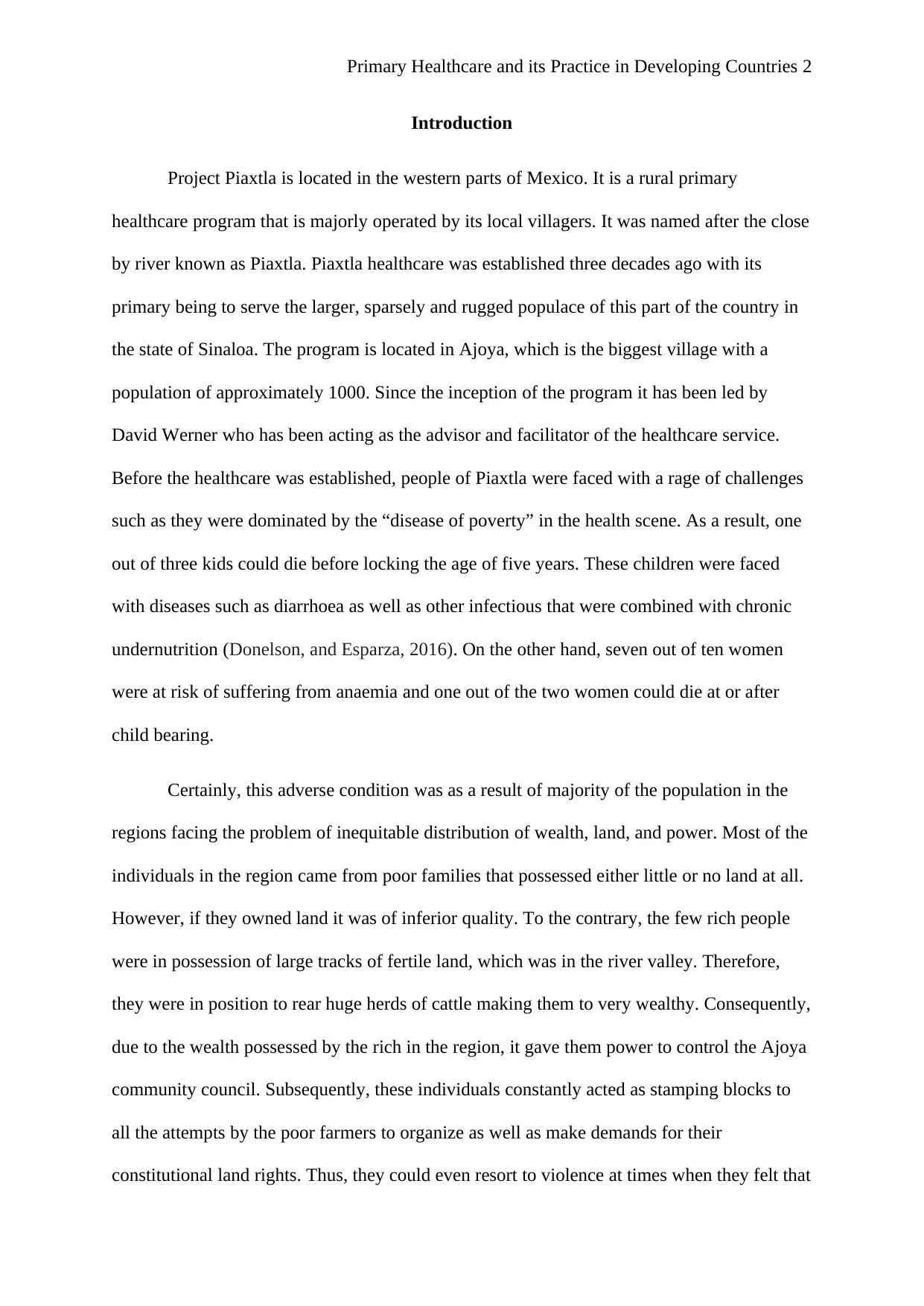
Primary Healthcare and its Practice in Developing Countries 2
Introduction
Project Piaxtla is located in the western parts of Mexico. It is a rural primary
healthcare program that is majorly operated by its local villagers. It was named after the close
by river known as Piaxtla. Piaxtla healthcare was established three decades ago with its
primary being to serve the larger, sparsely and rugged populace of this part of the country in
the state of Sinaloa. The program is located in Ajoya, which is the biggest village with a
population of approximately 1000. Since the inception of the program it has been led by
David Werner who has been acting as the advisor and facilitator of the healthcare service.
Before the healthcare was established, people of Piaxtla were faced with a rage of challenges
such as they were dominated by the “disease of poverty” in the health scene. As a result, one
out of three kids could die before locking the age of five years. These children were faced
with diseases such as diarrhoea as well as other infectious that were combined with chronic
undernutrition (Donelson, and Esparza, 2016). On the other hand, seven out of ten women
were at risk of suffering from anaemia and one out of the two women could die at or after
child bearing.
Certainly, this adverse condition was as a result of majority of the population in the
regions facing the problem of inequitable distribution of wealth, land, and power. Most of the
individuals in the region came from poor families that possessed either little or no land at all.
However, if they owned land it was of inferior quality. To the contrary, the few rich people
were in possession of large tracks of fertile land, which was in the river valley. Therefore,
they were in position to rear huge herds of cattle making them to very wealthy. Consequently,
due to the wealth possessed by the rich in the region, it gave them power to control the Ajoya
community council. Subsequently, these individuals constantly acted as stamping blocks to
all the attempts by the poor farmers to organize as well as make demands for their
constitutional land rights. Thus, they could even resort to violence at times when they felt that
Introduction
Project Piaxtla is located in the western parts of Mexico. It is a rural primary
healthcare program that is majorly operated by its local villagers. It was named after the close
by river known as Piaxtla. Piaxtla healthcare was established three decades ago with its
primary being to serve the larger, sparsely and rugged populace of this part of the country in
the state of Sinaloa. The program is located in Ajoya, which is the biggest village with a
population of approximately 1000. Since the inception of the program it has been led by
David Werner who has been acting as the advisor and facilitator of the healthcare service.
Before the healthcare was established, people of Piaxtla were faced with a rage of challenges
such as they were dominated by the “disease of poverty” in the health scene. As a result, one
out of three kids could die before locking the age of five years. These children were faced
with diseases such as diarrhoea as well as other infectious that were combined with chronic
undernutrition (Donelson, and Esparza, 2016). On the other hand, seven out of ten women
were at risk of suffering from anaemia and one out of the two women could die at or after
child bearing.
Certainly, this adverse condition was as a result of majority of the population in the
regions facing the problem of inequitable distribution of wealth, land, and power. Most of the
individuals in the region came from poor families that possessed either little or no land at all.
However, if they owned land it was of inferior quality. To the contrary, the few rich people
were in possession of large tracks of fertile land, which was in the river valley. Therefore,
they were in position to rear huge herds of cattle making them to very wealthy. Consequently,
due to the wealth possessed by the rich in the region, it gave them power to control the Ajoya
community council. Subsequently, these individuals constantly acted as stamping blocks to
all the attempts by the poor farmers to organize as well as make demands for their
constitutional land rights. Thus, they could even resort to violence at times when they felt that
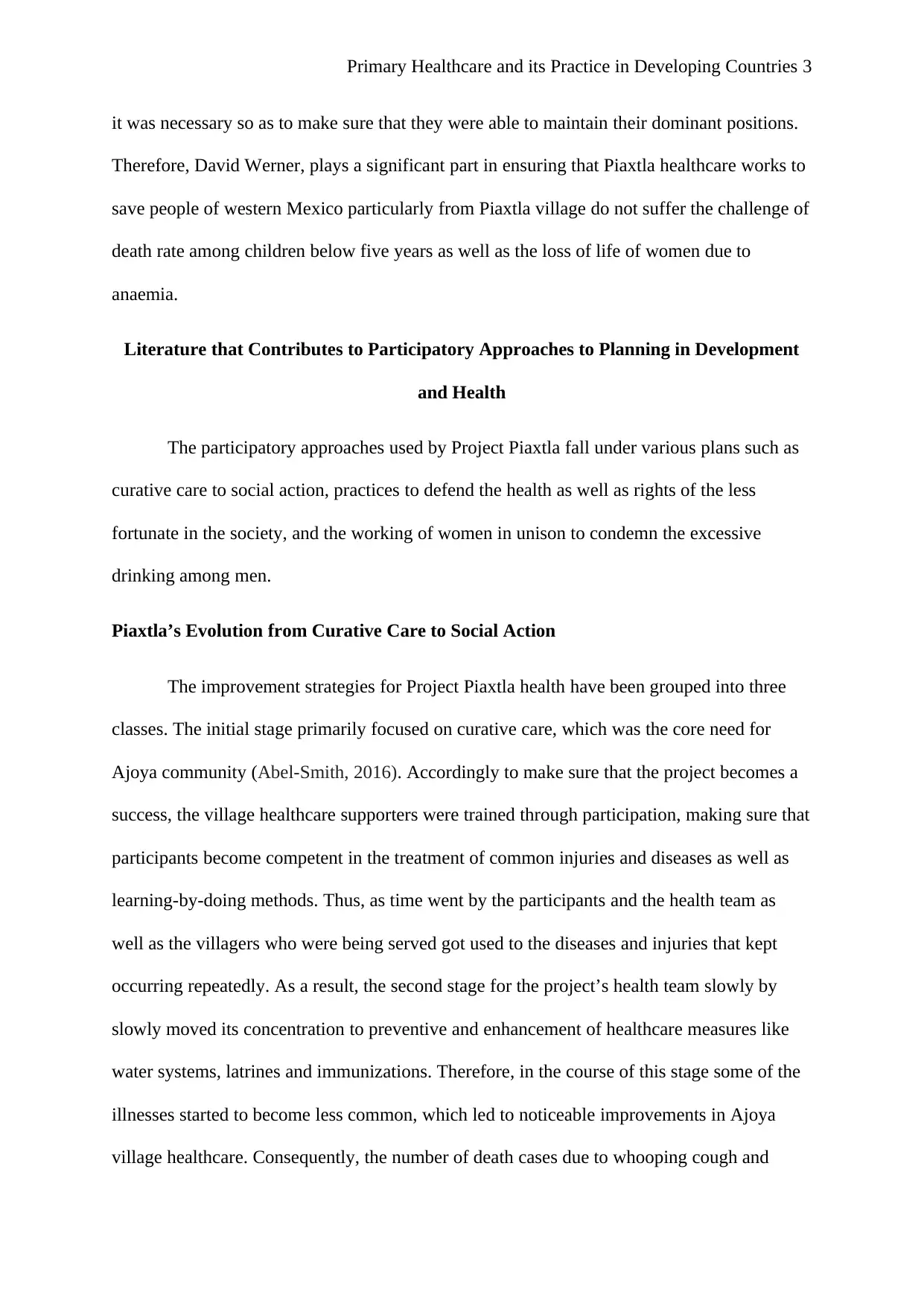
Primary Healthcare and its Practice in Developing Countries 3
it was necessary so as to make sure that they were able to maintain their dominant positions.
Therefore, David Werner, plays a significant part in ensuring that Piaxtla healthcare works to
save people of western Mexico particularly from Piaxtla village do not suffer the challenge of
death rate among children below five years as well as the loss of life of women due to
anaemia.
Literature that Contributes to Participatory Approaches to Planning in Development
and Health
The participatory approaches used by Project Piaxtla fall under various plans such as
curative care to social action, practices to defend the health as well as rights of the less
fortunate in the society, and the working of women in unison to condemn the excessive
drinking among men.
Piaxtla’s Evolution from Curative Care to Social Action
The improvement strategies for Project Piaxtla health have been grouped into three
classes. The initial stage primarily focused on curative care, which was the core need for
Ajoya community (Abel-Smith, 2016). Accordingly to make sure that the project becomes a
success, the village healthcare supporters were trained through participation, making sure that
participants become competent in the treatment of common injuries and diseases as well as
learning-by-doing methods. Thus, as time went by the participants and the health team as
well as the villagers who were being served got used to the diseases and injuries that kept
occurring repeatedly. As a result, the second stage for the project’s health team slowly by
slowly moved its concentration to preventive and enhancement of healthcare measures like
water systems, latrines and immunizations. Therefore, in the course of this stage some of the
illnesses started to become less common, which led to noticeable improvements in Ajoya
village healthcare. Consequently, the number of death cases due to whooping cough and
it was necessary so as to make sure that they were able to maintain their dominant positions.
Therefore, David Werner, plays a significant part in ensuring that Piaxtla healthcare works to
save people of western Mexico particularly from Piaxtla village do not suffer the challenge of
death rate among children below five years as well as the loss of life of women due to
anaemia.
Literature that Contributes to Participatory Approaches to Planning in Development
and Health
The participatory approaches used by Project Piaxtla fall under various plans such as
curative care to social action, practices to defend the health as well as rights of the less
fortunate in the society, and the working of women in unison to condemn the excessive
drinking among men.
Piaxtla’s Evolution from Curative Care to Social Action
The improvement strategies for Project Piaxtla health have been grouped into three
classes. The initial stage primarily focused on curative care, which was the core need for
Ajoya community (Abel-Smith, 2016). Accordingly to make sure that the project becomes a
success, the village healthcare supporters were trained through participation, making sure that
participants become competent in the treatment of common injuries and diseases as well as
learning-by-doing methods. Thus, as time went by the participants and the health team as
well as the villagers who were being served got used to the diseases and injuries that kept
occurring repeatedly. As a result, the second stage for the project’s health team slowly by
slowly moved its concentration to preventive and enhancement of healthcare measures like
water systems, latrines and immunizations. Therefore, in the course of this stage some of the
illnesses started to become less common, which led to noticeable improvements in Ajoya
village healthcare. Consequently, the number of death cases due to whooping cough and
⊘ This is a preview!⊘
Do you want full access?
Subscribe today to unlock all pages.

Trusted by 1+ million students worldwide
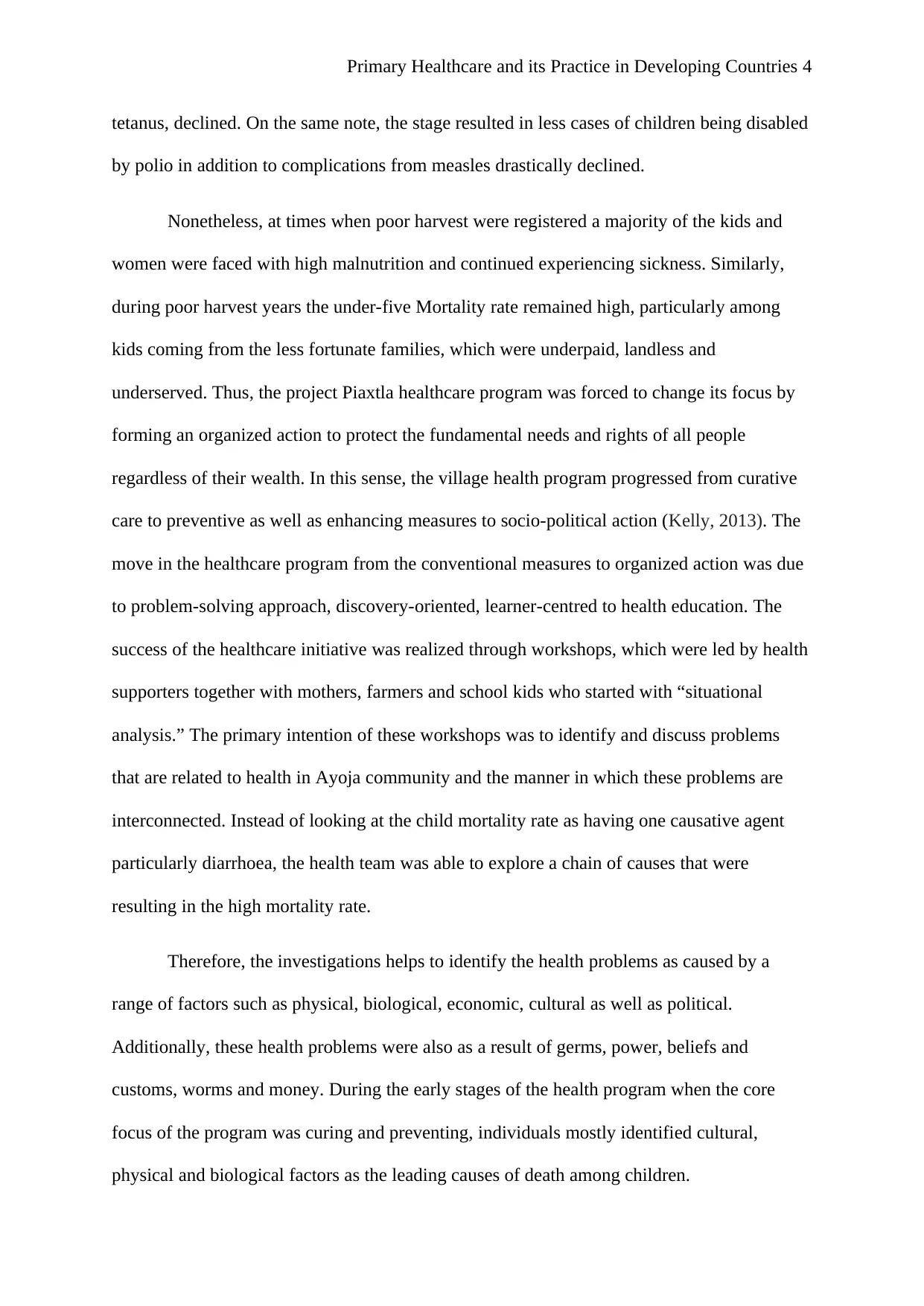
Primary Healthcare and its Practice in Developing Countries 4
tetanus, declined. On the same note, the stage resulted in less cases of children being disabled
by polio in addition to complications from measles drastically declined.
Nonetheless, at times when poor harvest were registered a majority of the kids and
women were faced with high malnutrition and continued experiencing sickness. Similarly,
during poor harvest years the under-five Mortality rate remained high, particularly among
kids coming from the less fortunate families, which were underpaid, landless and
underserved. Thus, the project Piaxtla healthcare program was forced to change its focus by
forming an organized action to protect the fundamental needs and rights of all people
regardless of their wealth. In this sense, the village health program progressed from curative
care to preventive as well as enhancing measures to socio-political action (Kelly, 2013). The
move in the healthcare program from the conventional measures to organized action was due
to problem-solving approach, discovery-oriented, learner-centred to health education. The
success of the healthcare initiative was realized through workshops, which were led by health
supporters together with mothers, farmers and school kids who started with “situational
analysis.” The primary intention of these workshops was to identify and discuss problems
that are related to health in Ayoja community and the manner in which these problems are
interconnected. Instead of looking at the child mortality rate as having one causative agent
particularly diarrhoea, the health team was able to explore a chain of causes that were
resulting in the high mortality rate.
Therefore, the investigations helps to identify the health problems as caused by a
range of factors such as physical, biological, economic, cultural as well as political.
Additionally, these health problems were also as a result of germs, power, beliefs and
customs, worms and money. During the early stages of the health program when the core
focus of the program was curing and preventing, individuals mostly identified cultural,
physical and biological factors as the leading causes of death among children.
tetanus, declined. On the same note, the stage resulted in less cases of children being disabled
by polio in addition to complications from measles drastically declined.
Nonetheless, at times when poor harvest were registered a majority of the kids and
women were faced with high malnutrition and continued experiencing sickness. Similarly,
during poor harvest years the under-five Mortality rate remained high, particularly among
kids coming from the less fortunate families, which were underpaid, landless and
underserved. Thus, the project Piaxtla healthcare program was forced to change its focus by
forming an organized action to protect the fundamental needs and rights of all people
regardless of their wealth. In this sense, the village health program progressed from curative
care to preventive as well as enhancing measures to socio-political action (Kelly, 2013). The
move in the healthcare program from the conventional measures to organized action was due
to problem-solving approach, discovery-oriented, learner-centred to health education. The
success of the healthcare initiative was realized through workshops, which were led by health
supporters together with mothers, farmers and school kids who started with “situational
analysis.” The primary intention of these workshops was to identify and discuss problems
that are related to health in Ayoja community and the manner in which these problems are
interconnected. Instead of looking at the child mortality rate as having one causative agent
particularly diarrhoea, the health team was able to explore a chain of causes that were
resulting in the high mortality rate.
Therefore, the investigations helps to identify the health problems as caused by a
range of factors such as physical, biological, economic, cultural as well as political.
Additionally, these health problems were also as a result of germs, power, beliefs and
customs, worms and money. During the early stages of the health program when the core
focus of the program was curing and preventing, individuals mostly identified cultural,
physical and biological factors as the leading causes of death among children.
Paraphrase This Document
Need a fresh take? Get an instant paraphrase of this document with our AI Paraphraser
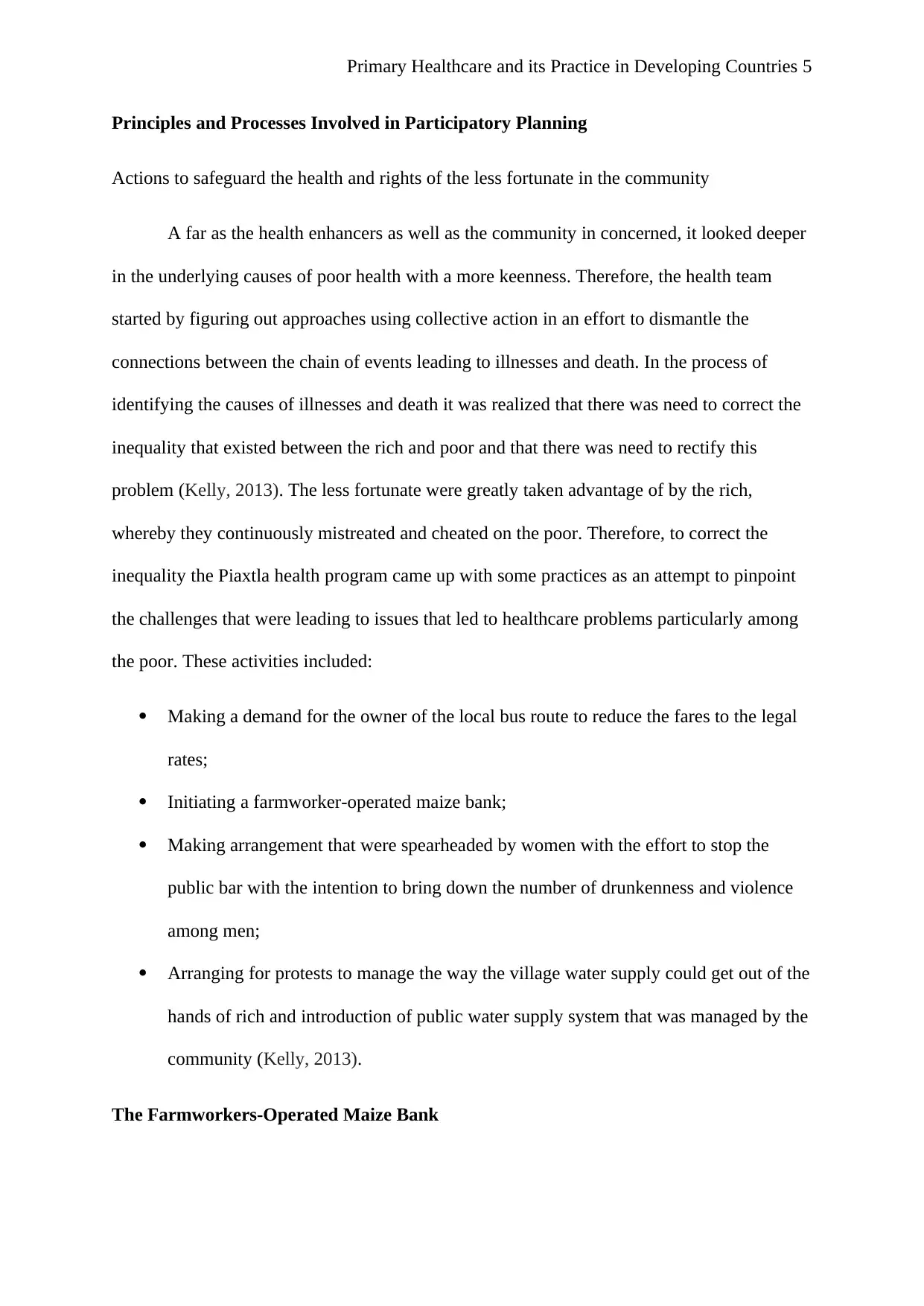
Primary Healthcare and its Practice in Developing Countries 5
Principles and Processes Involved in Participatory Planning
Actions to safeguard the health and rights of the less fortunate in the community
A far as the health enhancers as well as the community in concerned, it looked deeper
in the underlying causes of poor health with a more keenness. Therefore, the health team
started by figuring out approaches using collective action in an effort to dismantle the
connections between the chain of events leading to illnesses and death. In the process of
identifying the causes of illnesses and death it was realized that there was need to correct the
inequality that existed between the rich and poor and that there was need to rectify this
problem (Kelly, 2013). The less fortunate were greatly taken advantage of by the rich,
whereby they continuously mistreated and cheated on the poor. Therefore, to correct the
inequality the Piaxtla health program came up with some practices as an attempt to pinpoint
the challenges that were leading to issues that led to healthcare problems particularly among
the poor. These activities included:
Making a demand for the owner of the local bus route to reduce the fares to the legal
rates;
Initiating a farmworker-operated maize bank;
Making arrangement that were spearheaded by women with the effort to stop the
public bar with the intention to bring down the number of drunkenness and violence
among men;
Arranging for protests to manage the way the village water supply could get out of the
hands of rich and introduction of public water supply system that was managed by the
community (Kelly, 2013).
The Farmworkers-Operated Maize Bank
Principles and Processes Involved in Participatory Planning
Actions to safeguard the health and rights of the less fortunate in the community
A far as the health enhancers as well as the community in concerned, it looked deeper
in the underlying causes of poor health with a more keenness. Therefore, the health team
started by figuring out approaches using collective action in an effort to dismantle the
connections between the chain of events leading to illnesses and death. In the process of
identifying the causes of illnesses and death it was realized that there was need to correct the
inequality that existed between the rich and poor and that there was need to rectify this
problem (Kelly, 2013). The less fortunate were greatly taken advantage of by the rich,
whereby they continuously mistreated and cheated on the poor. Therefore, to correct the
inequality the Piaxtla health program came up with some practices as an attempt to pinpoint
the challenges that were leading to issues that led to healthcare problems particularly among
the poor. These activities included:
Making a demand for the owner of the local bus route to reduce the fares to the legal
rates;
Initiating a farmworker-operated maize bank;
Making arrangement that were spearheaded by women with the effort to stop the
public bar with the intention to bring down the number of drunkenness and violence
among men;
Arranging for protests to manage the way the village water supply could get out of the
hands of rich and introduction of public water supply system that was managed by the
community (Kelly, 2013).
The Farmworkers-Operated Maize Bank
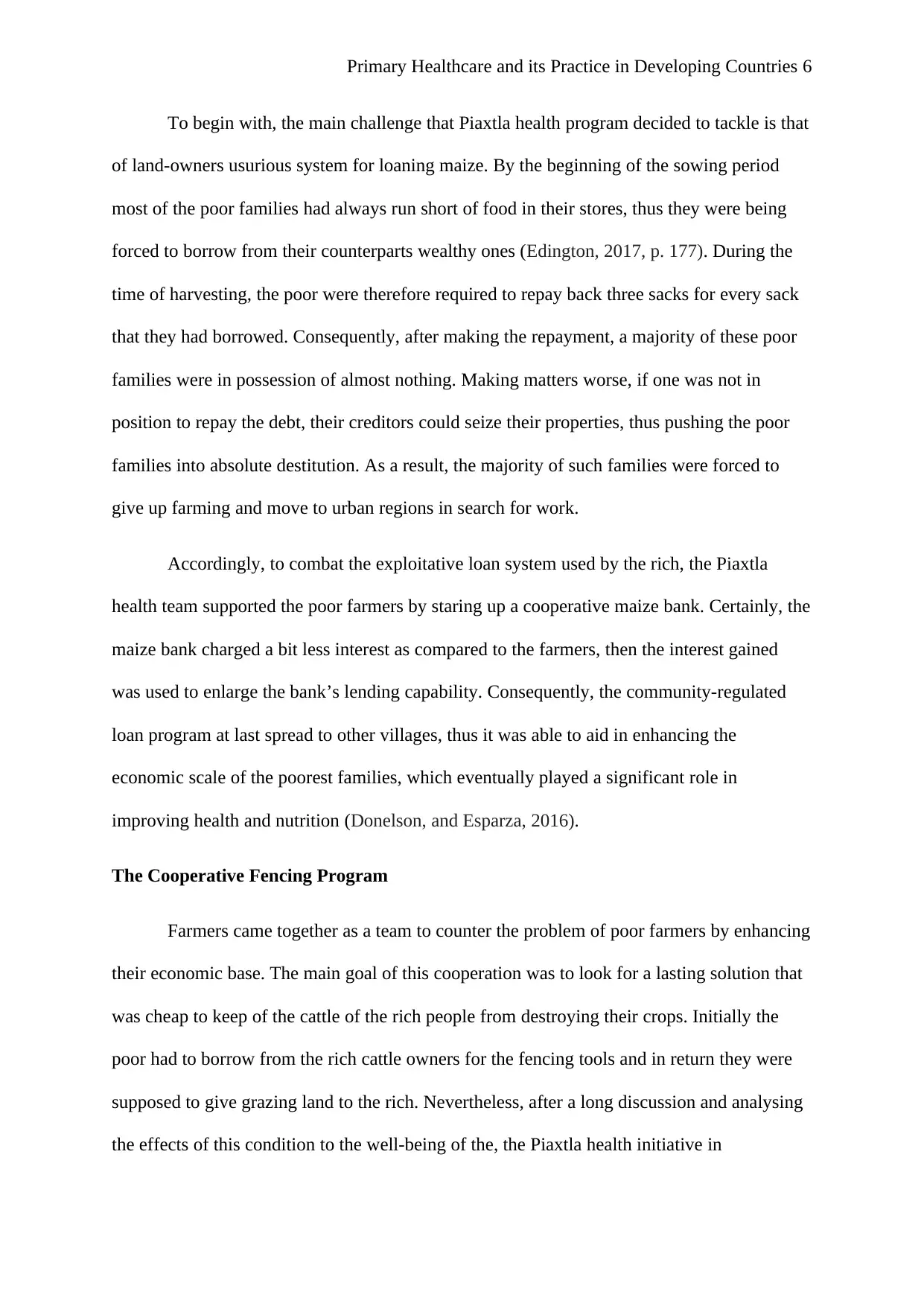
Primary Healthcare and its Practice in Developing Countries 6
To begin with, the main challenge that Piaxtla health program decided to tackle is that
of land-owners usurious system for loaning maize. By the beginning of the sowing period
most of the poor families had always run short of food in their stores, thus they were being
forced to borrow from their counterparts wealthy ones (Edington, 2017, p. 177). During the
time of harvesting, the poor were therefore required to repay back three sacks for every sack
that they had borrowed. Consequently, after making the repayment, a majority of these poor
families were in possession of almost nothing. Making matters worse, if one was not in
position to repay the debt, their creditors could seize their properties, thus pushing the poor
families into absolute destitution. As a result, the majority of such families were forced to
give up farming and move to urban regions in search for work.
Accordingly, to combat the exploitative loan system used by the rich, the Piaxtla
health team supported the poor farmers by staring up a cooperative maize bank. Certainly, the
maize bank charged a bit less interest as compared to the farmers, then the interest gained
was used to enlarge the bank’s lending capability. Consequently, the community-regulated
loan program at last spread to other villages, thus it was able to aid in enhancing the
economic scale of the poorest families, which eventually played a significant role in
improving health and nutrition (Donelson, and Esparza, 2016).
The Cooperative Fencing Program
Farmers came together as a team to counter the problem of poor farmers by enhancing
their economic base. The main goal of this cooperation was to look for a lasting solution that
was cheap to keep of the cattle of the rich people from destroying their crops. Initially the
poor had to borrow from the rich cattle owners for the fencing tools and in return they were
supposed to give grazing land to the rich. Nevertheless, after a long discussion and analysing
the effects of this condition to the well-being of the, the Piaxtla health initiative in
To begin with, the main challenge that Piaxtla health program decided to tackle is that
of land-owners usurious system for loaning maize. By the beginning of the sowing period
most of the poor families had always run short of food in their stores, thus they were being
forced to borrow from their counterparts wealthy ones (Edington, 2017, p. 177). During the
time of harvesting, the poor were therefore required to repay back three sacks for every sack
that they had borrowed. Consequently, after making the repayment, a majority of these poor
families were in possession of almost nothing. Making matters worse, if one was not in
position to repay the debt, their creditors could seize their properties, thus pushing the poor
families into absolute destitution. As a result, the majority of such families were forced to
give up farming and move to urban regions in search for work.
Accordingly, to combat the exploitative loan system used by the rich, the Piaxtla
health team supported the poor farmers by staring up a cooperative maize bank. Certainly, the
maize bank charged a bit less interest as compared to the farmers, then the interest gained
was used to enlarge the bank’s lending capability. Consequently, the community-regulated
loan program at last spread to other villages, thus it was able to aid in enhancing the
economic scale of the poorest families, which eventually played a significant role in
improving health and nutrition (Donelson, and Esparza, 2016).
The Cooperative Fencing Program
Farmers came together as a team to counter the problem of poor farmers by enhancing
their economic base. The main goal of this cooperation was to look for a lasting solution that
was cheap to keep of the cattle of the rich people from destroying their crops. Initially the
poor had to borrow from the rich cattle owners for the fencing tools and in return they were
supposed to give grazing land to the rich. Nevertheless, after a long discussion and analysing
the effects of this condition to the well-being of the, the Piaxtla health initiative in
⊘ This is a preview!⊘
Do you want full access?
Subscribe today to unlock all pages.

Trusted by 1+ million students worldwide

Primary Healthcare and its Practice in Developing Countries 7
collaboration with the small members’ organization started to explore for the likely solutions.
As a result, the health team makes arrangements for the poor people to come together and
collectively fence their land as a team (Cueto, 2004, pp.1864-1866). The starting capital was
got from a nongovernmental organization courtesy of the health program and after fencing
their land the poor were in a position to charge the rich for grazing on their land. Thus it
become possible for them to repay the loan in a period of two years. After the first loan was
repaid the same money was given to a new group of farmers. Therefore by revolving the
funds among the poor farmers the initiative helps the poor to become more self-reliant.
Consequently, it aids to reduce the gap between the rich and the poor thus, the health of most
of the children from the poor families begun to change because children were now able to get
enough food to eat.
In addition, as a result of the organized actions, the poor in the region started to gain
confidence as well as experience due to the strength of the cooperation. The ability of poor
farmers working through cooperatives empowers them in various ways which in turn comes
out as successful and it was within no time routine since all the poor farmers in the nearby
villages had joined the informal but cohesive organizations (Cueto, 2004, p. 1871). Indeed, as
the number of poor farmers kept rising the spirit of solidarity also kept growing, thus likewise
to the health team, which leads to a bigger combat against the highly dangerous matters that
was affecting them.
Critical Analysis using a Theory as a Framework
Women coming together against the drunkenness of men
The women of Ajoya as well as the nearby villages started to discover and put their
power into action and one way in which they exercised their power was to take a collective
act to pinpoint the problem of excessive alcohol abuse among men. The problem of excessive
collaboration with the small members’ organization started to explore for the likely solutions.
As a result, the health team makes arrangements for the poor people to come together and
collectively fence their land as a team (Cueto, 2004, pp.1864-1866). The starting capital was
got from a nongovernmental organization courtesy of the health program and after fencing
their land the poor were in a position to charge the rich for grazing on their land. Thus it
become possible for them to repay the loan in a period of two years. After the first loan was
repaid the same money was given to a new group of farmers. Therefore by revolving the
funds among the poor farmers the initiative helps the poor to become more self-reliant.
Consequently, it aids to reduce the gap between the rich and the poor thus, the health of most
of the children from the poor families begun to change because children were now able to get
enough food to eat.
In addition, as a result of the organized actions, the poor in the region started to gain
confidence as well as experience due to the strength of the cooperation. The ability of poor
farmers working through cooperatives empowers them in various ways which in turn comes
out as successful and it was within no time routine since all the poor farmers in the nearby
villages had joined the informal but cohesive organizations (Cueto, 2004, p. 1871). Indeed, as
the number of poor farmers kept rising the spirit of solidarity also kept growing, thus likewise
to the health team, which leads to a bigger combat against the highly dangerous matters that
was affecting them.
Critical Analysis using a Theory as a Framework
Women coming together against the drunkenness of men
The women of Ajoya as well as the nearby villages started to discover and put their
power into action and one way in which they exercised their power was to take a collective
act to pinpoint the problem of excessive alcohol abuse among men. The problem of excessive
Paraphrase This Document
Need a fresh take? Get an instant paraphrase of this document with our AI Paraphraser
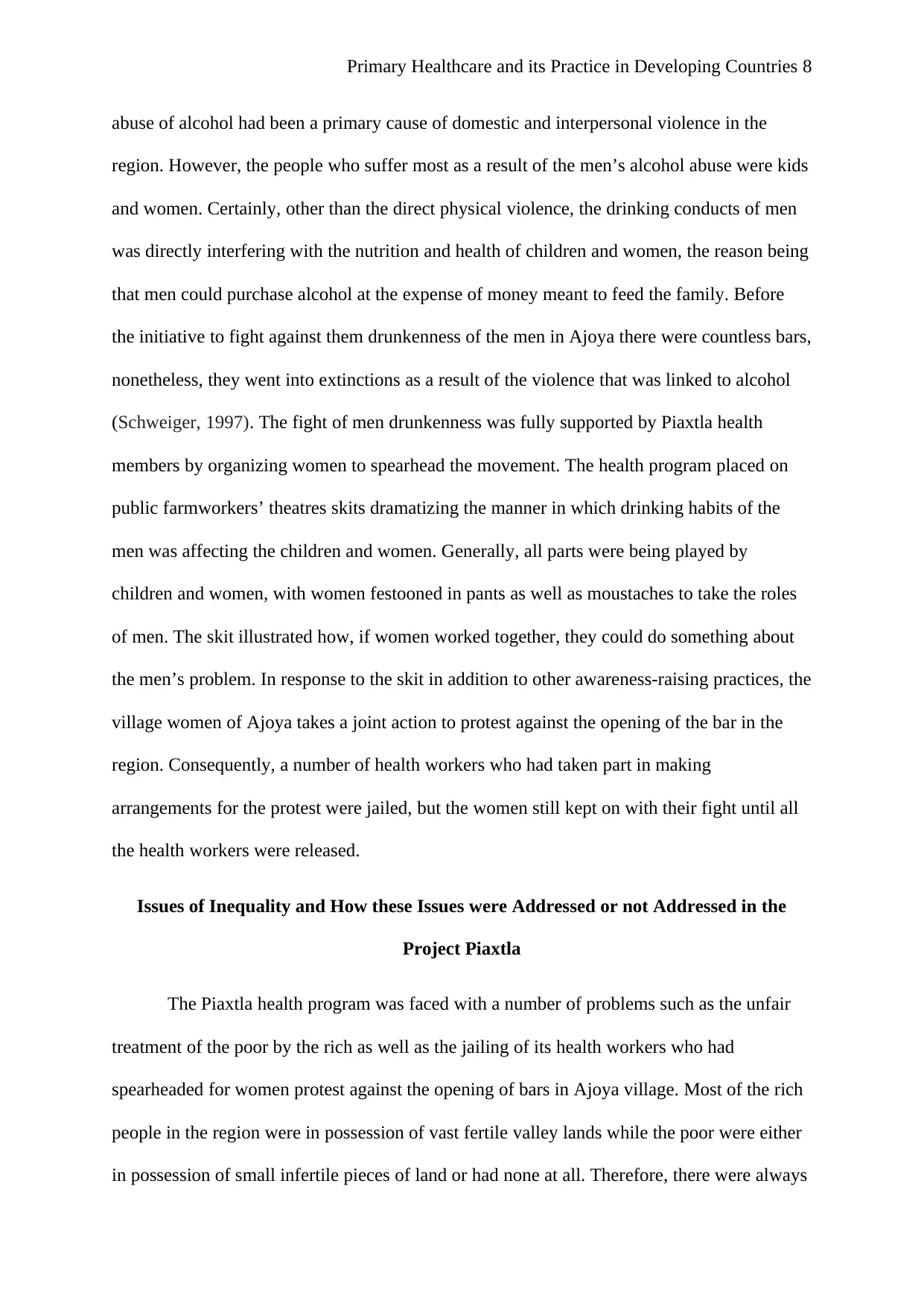
Primary Healthcare and its Practice in Developing Countries 8
abuse of alcohol had been a primary cause of domestic and interpersonal violence in the
region. However, the people who suffer most as a result of the men’s alcohol abuse were kids
and women. Certainly, other than the direct physical violence, the drinking conducts of men
was directly interfering with the nutrition and health of children and women, the reason being
that men could purchase alcohol at the expense of money meant to feed the family. Before
the initiative to fight against them drunkenness of the men in Ajoya there were countless bars,
nonetheless, they went into extinctions as a result of the violence that was linked to alcohol
(Schweiger, 1997). The fight of men drunkenness was fully supported by Piaxtla health
members by organizing women to spearhead the movement. The health program placed on
public farmworkers’ theatres skits dramatizing the manner in which drinking habits of the
men was affecting the children and women. Generally, all parts were being played by
children and women, with women festooned in pants as well as moustaches to take the roles
of men. The skit illustrated how, if women worked together, they could do something about
the men’s problem. In response to the skit in addition to other awareness-raising practices, the
village women of Ajoya takes a joint action to protest against the opening of the bar in the
region. Consequently, a number of health workers who had taken part in making
arrangements for the protest were jailed, but the women still kept on with their fight until all
the health workers were released.
Issues of Inequality and How these Issues were Addressed or not Addressed in the
Project Piaxtla
The Piaxtla health program was faced with a number of problems such as the unfair
treatment of the poor by the rich as well as the jailing of its health workers who had
spearheaded for women protest against the opening of bars in Ajoya village. Most of the rich
people in the region were in possession of vast fertile valley lands while the poor were either
in possession of small infertile pieces of land or had none at all. Therefore, there were always
abuse of alcohol had been a primary cause of domestic and interpersonal violence in the
region. However, the people who suffer most as a result of the men’s alcohol abuse were kids
and women. Certainly, other than the direct physical violence, the drinking conducts of men
was directly interfering with the nutrition and health of children and women, the reason being
that men could purchase alcohol at the expense of money meant to feed the family. Before
the initiative to fight against them drunkenness of the men in Ajoya there were countless bars,
nonetheless, they went into extinctions as a result of the violence that was linked to alcohol
(Schweiger, 1997). The fight of men drunkenness was fully supported by Piaxtla health
members by organizing women to spearhead the movement. The health program placed on
public farmworkers’ theatres skits dramatizing the manner in which drinking habits of the
men was affecting the children and women. Generally, all parts were being played by
children and women, with women festooned in pants as well as moustaches to take the roles
of men. The skit illustrated how, if women worked together, they could do something about
the men’s problem. In response to the skit in addition to other awareness-raising practices, the
village women of Ajoya takes a joint action to protest against the opening of the bar in the
region. Consequently, a number of health workers who had taken part in making
arrangements for the protest were jailed, but the women still kept on with their fight until all
the health workers were released.
Issues of Inequality and How these Issues were Addressed or not Addressed in the
Project Piaxtla
The Piaxtla health program was faced with a number of problems such as the unfair
treatment of the poor by the rich as well as the jailing of its health workers who had
spearheaded for women protest against the opening of bars in Ajoya village. Most of the rich
people in the region were in possession of vast fertile valley lands while the poor were either
in possession of small infertile pieces of land or had none at all. Therefore, there were always
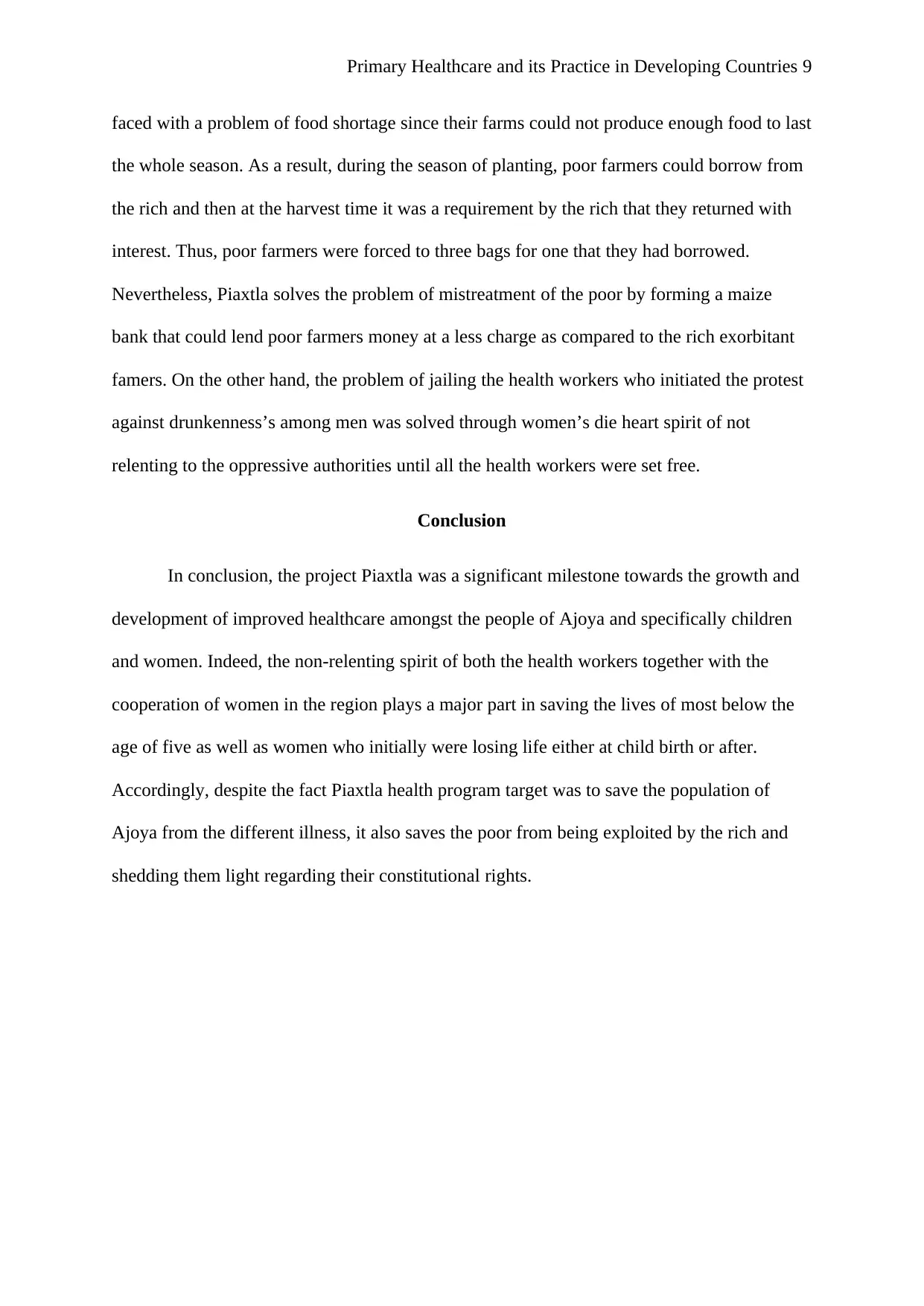
Primary Healthcare and its Practice in Developing Countries 9
faced with a problem of food shortage since their farms could not produce enough food to last
the whole season. As a result, during the season of planting, poor farmers could borrow from
the rich and then at the harvest time it was a requirement by the rich that they returned with
interest. Thus, poor farmers were forced to three bags for one that they had borrowed.
Nevertheless, Piaxtla solves the problem of mistreatment of the poor by forming a maize
bank that could lend poor farmers money at a less charge as compared to the rich exorbitant
famers. On the other hand, the problem of jailing the health workers who initiated the protest
against drunkenness’s among men was solved through women’s die heart spirit of not
relenting to the oppressive authorities until all the health workers were set free.
Conclusion
In conclusion, the project Piaxtla was a significant milestone towards the growth and
development of improved healthcare amongst the people of Ajoya and specifically children
and women. Indeed, the non-relenting spirit of both the health workers together with the
cooperation of women in the region plays a major part in saving the lives of most below the
age of five as well as women who initially were losing life either at child birth or after.
Accordingly, despite the fact Piaxtla health program target was to save the population of
Ajoya from the different illness, it also saves the poor from being exploited by the rich and
shedding them light regarding their constitutional rights.
faced with a problem of food shortage since their farms could not produce enough food to last
the whole season. As a result, during the season of planting, poor farmers could borrow from
the rich and then at the harvest time it was a requirement by the rich that they returned with
interest. Thus, poor farmers were forced to three bags for one that they had borrowed.
Nevertheless, Piaxtla solves the problem of mistreatment of the poor by forming a maize
bank that could lend poor farmers money at a less charge as compared to the rich exorbitant
famers. On the other hand, the problem of jailing the health workers who initiated the protest
against drunkenness’s among men was solved through women’s die heart spirit of not
relenting to the oppressive authorities until all the health workers were set free.
Conclusion
In conclusion, the project Piaxtla was a significant milestone towards the growth and
development of improved healthcare amongst the people of Ajoya and specifically children
and women. Indeed, the non-relenting spirit of both the health workers together with the
cooperation of women in the region plays a major part in saving the lives of most below the
age of five as well as women who initially were losing life either at child birth or after.
Accordingly, despite the fact Piaxtla health program target was to save the population of
Ajoya from the different illness, it also saves the poor from being exploited by the rich and
shedding them light regarding their constitutional rights.
⊘ This is a preview!⊘
Do you want full access?
Subscribe today to unlock all pages.

Trusted by 1+ million students worldwide

Primary Healthcare and its Practice in Developing Countries 10
Bibliography
Kelly, J.K., 2013. Village-Scale Practices and Water Sources in Indigenous Mexico after the
Neoliberalizing of Social Property (Doctoral dissertation, University of Kansas).
Donelson, A.J. and Esparza, A.X., 2016. The Colonias Reader: Economy, Housing and
Public Health in US-Mexico Border Colonias. University of Arizona Press.
Edington, J., 2017. Indigenous Knowledge and the Course of Development. In Indigenous
Environmental Knowledge (pp. 171-201). Springer, Cham.
Abel-Smith, B., 2016. An introduction to health: policy, planning and financing. Routledge.
Schweiger, M., 1997. Questioning the solution: the politics of primary health care and child
survival. BMJ, 315(7107), p.555.
Cueto, M., 2004. The origins of primary health care and selective primary health
care. American journal of public health, 94(11), pp.1864-1874.
Bibliography
Kelly, J.K., 2013. Village-Scale Practices and Water Sources in Indigenous Mexico after the
Neoliberalizing of Social Property (Doctoral dissertation, University of Kansas).
Donelson, A.J. and Esparza, A.X., 2016. The Colonias Reader: Economy, Housing and
Public Health in US-Mexico Border Colonias. University of Arizona Press.
Edington, J., 2017. Indigenous Knowledge and the Course of Development. In Indigenous
Environmental Knowledge (pp. 171-201). Springer, Cham.
Abel-Smith, B., 2016. An introduction to health: policy, planning and financing. Routledge.
Schweiger, M., 1997. Questioning the solution: the politics of primary health care and child
survival. BMJ, 315(7107), p.555.
Cueto, M., 2004. The origins of primary health care and selective primary health
care. American journal of public health, 94(11), pp.1864-1874.
1 out of 10
Related Documents
Your All-in-One AI-Powered Toolkit for Academic Success.
+13062052269
info@desklib.com
Available 24*7 on WhatsApp / Email
![[object Object]](/_next/static/media/star-bottom.7253800d.svg)
Unlock your academic potential
Copyright © 2020–2025 A2Z Services. All Rights Reserved. Developed and managed by ZUCOL.




